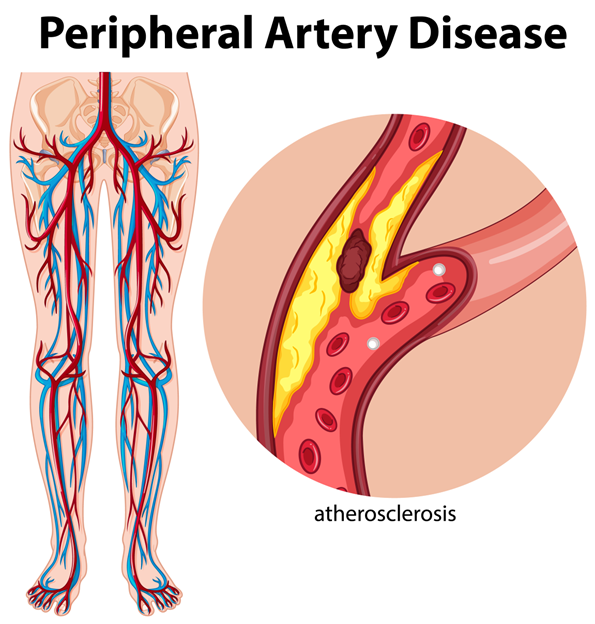Peripheral Artery Disease, or PAD, is a condition where your arteries become narrow, limiting blood flow to the limbs. In India, clinical manifestations of PAD are widespread, affecting millions of people. This condition often goes unnoticed because early symptoms of PAD can be subtle. Recognizing PAD leg cramps and other signs early can be crucial for effective management. This blog aims to help you understand, identify, and manage the early signs of PAD, providing essential patient education to improve awareness and health outcomes.
Understanding Peripheral Artery Disease
Peripheral Artery Disease materializes when arteries narrow, usually due to plaque buildup. This narrowing disrupts blood delivery to the limbs, particularly the legs, leading to various symptoms. The lack of sufficient blood flow results in pain, especially during activities. Several factors elevate the risk of PAD, including smoking, diabetes, high cholesterol, and high blood pressure. Older adults are more prone to PAD, especially those over 60. Ensuring regular health check-ups is vital to understand your risk of developing PAD. By recognizing these risks early, you can better manage and prevent the progression of the disease.
Recognizing Common Symptoms of PAD
One of the primary symptoms of PAD is intermittent claudication—a condition causing pain during walking or exercising due to poor blood flow. PAD leg cramps occur because muscles are not getting enough blood during activity. Usually, this pain happens in calf muscles and eases with rest. However, as the disease progresses, the pain may persist even during rest.
Other signs may include: – A noticeable weak pulse in legs or feet – Skin on legs feels cold to the touch – Slow-healing wounds or sores – Change in the skin color or texture on the legs – Poor nail growth and reduced hair growth on the legs
Understanding these pad pvd symptoms can lead to earlier detection and treatment. Often, symptoms of pad can look like normal aging signs, so staying alert is essential.
Unveiling Often-Missed Subtle Signs of PAD
Some PAD symptoms are subtle, such as numbness or weakness in the legs. Early stages might be asymptomatic, so even minor discomfort shouldn’t be ignored. Often, these subtle signs mimic typical aging processes, making it challenging to pin down until the condition advances. Pay attention to these subtle clinical manifestations of PAD to prevent delay in seeking medical help.
When to Seek Medical Help
Be on the lookout for warning signs that require immediate medical attention. Persistent PAD leg cramps or pain during rest, leg weakness, or non-healing wounds are red flags. If you notice any of these symptoms, it’s time to see a doctor. During a medical appointment, several tests can help diagnose PAD, including imaging tests. Recognizing claudication pad and other symptoms of PAD should prompt you to take action without delays.
Managing Early Signs Effectively
Managing PAD involves a few lifestyle changes. Here are some practical tips: – Lifestyle Changes: Adopt a healthy diet and increase physical activity. Quit smoking to improve blood flow. – Medications: Doctors may prescribe medications to manage blood pressure and cholesterol. – Home Management: Take steps to relieve pain, practice good foot care, and adjust activities to manage discomfort.
These measures can greatly relieve PAD symptoms and improve quality of life.
Preventing PAD Progression
Preventing PAD from getting worse is about regular monitoring and lifestyle changes. Regular check-ups can help manage conditions that contribute to PAD. Long-term strategies should include maintaining a balanced diet, staying active, and quitting smoking. By regularly observing symptoms and seeking medical advice, you can help stop PAD from progressing further.
Living Well with PAD: Success Stories and Resources
Living with PAD can be manageable with the right lifestyle changes and support. Many have successfully coped with the condition by embracing healthier habits. Building a strong support system is critical, and there are many resources available for PAD patients, including community support groups and educational materials to guide you on this journey.
Conclusion: Encouragement for Proactive Health Management
Keeping an eye on the key symptoms of pad and detecting them early is crucial. This blog encourages proactive health management by recognizing the signs early, therefore, improving life quality. If any PAD symptoms resonate with you, seek medical advice promptly. A proactive approach can make all the difference.

